During the wee hours of St. Patrick’s Day 2013, I stood with two fellow photographers on a gravel causeway flanked by mountains on one side and the Pacific ocean on the other. Above us, the northern lights shimmered and flowed like giant waterfalls of red, purple and green. For six hours, we chased the aurora from one bay to another, joyously squeezing our cable releases.
While the auroral display was a show-stopper, its arrival was no surprise. We’d been stalking it for a couple hours. Let me share a few tips I’ve gleaned over the years so you, too, will be prepared for a great night of northern lights viewing–whether it’s on your home turf or while traveling.
First of all, your ability to see the northern lights depends on two factors:
- If the Northern Lights are “on” (the degree of geomagnetic activity, as in the disturbance of the earth’s magnetic field caused by the sun), and
- Your location on the planet
Are the Lights On?
No matter where we are in the 12-year solar cycle, your chances to view the aurora depends on the level of geomagnetic activity at the time you are viewing. This might sound dry, but without that energy to excite electrons in our atmosphere you don’t get northern lights. No energy, no lights.
The geomagnetic activity is measured using a simple index called Kp. The Kp index, says NOAA/Space Weather Prediction Center, is assigned a number from 0 to 9. The higher the number, the better the potential for great aurora viewing.
My favorite website for checking the Kp index (and other aspects of space activity) is Spaceweather.com. Here is a snapshot of Spaceweather.com taken December 20, 2013.
I like to start by reviewing What’s up in space which is located at the top. That’s where you learn about new CME’s (coronal mass ejections) which are explosive bursts of solar wind and magnetic fields that are released from the sun into space.
Once a CME has been released, that’s your signal to get ready because this burst of energy will sweep by the earth in 2 or 3 days.
For actual aurora forecasts, you have a couple choices:
- The Space Weather Prediction Center’s Solar-Geophysical Forecast (for the next 24-hours).
- The University of Alaska Fairbanks Geophysical Institute Aurora Forecast.
Note: Softservenews also provides an Aurora Borealis forecast, but it’s pretty much a conglomeration of the more official sites.
Periodically check in with the forecasters and especially with Spaceweather.com for updates and to sign up for alerts if you wish. By updates, I mean looking at the Current Auroral Oval. See that green rectangle I drew on the bottom left side of the above Spaceweather.com home page? That rectangle contains a lot of helpful information, including the Kp index.
Take a look at the Current Auroral Oval below, which is a snapshot I took on St. Patrick’s Day eve. You’re looking down at earth from space. Under the picture of the oval (which was a brilliant yellow, red and orange that night), you have the option of four different views: Europe, USA, New Zealand, and Antarctica. Go to the real-time Spaceweather.com page to find the oval that’s best for your location.
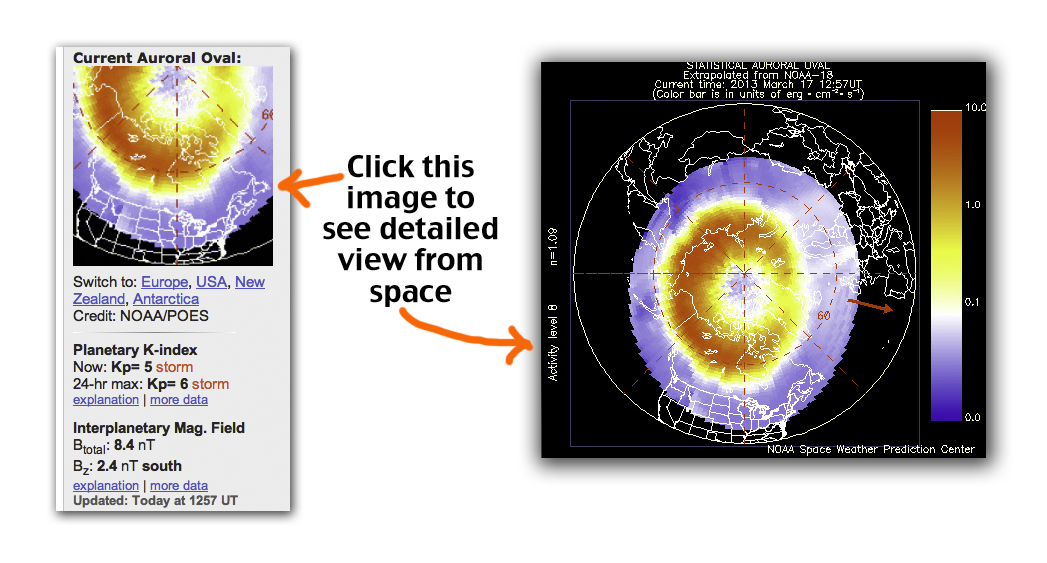
Listed below the four different views, you’ll see the Planetary K-index, which is updated every 3 hours. In the example shown here it reads:
Now: Kp= 5 storm. (A Kp value of 5 or greater is for “storm” which means intense geomagnetic activity, and an increased likelihood that the edge of the auroral boundary will drift to lower latitudes. More on that later).
For a more complete description of the relationship between Kp index and the Aurora, click on the explanation link below where it says, 24-hr max Kp. The Geophysical Institute also provides a fairly good pictorial explanation on their Interpreting the Aurora page.
The next helpful bit of information, though mostly for what has already occurred during the past couple days, is where it says more data. I took a screen snapshot of the bar graph below on March 17/18 after I came in to warm up after standing in the cold for so long. You can see the Kp index peaked at an average of 6, which is quite strong. (Anything above Kp=3 piques my interest).
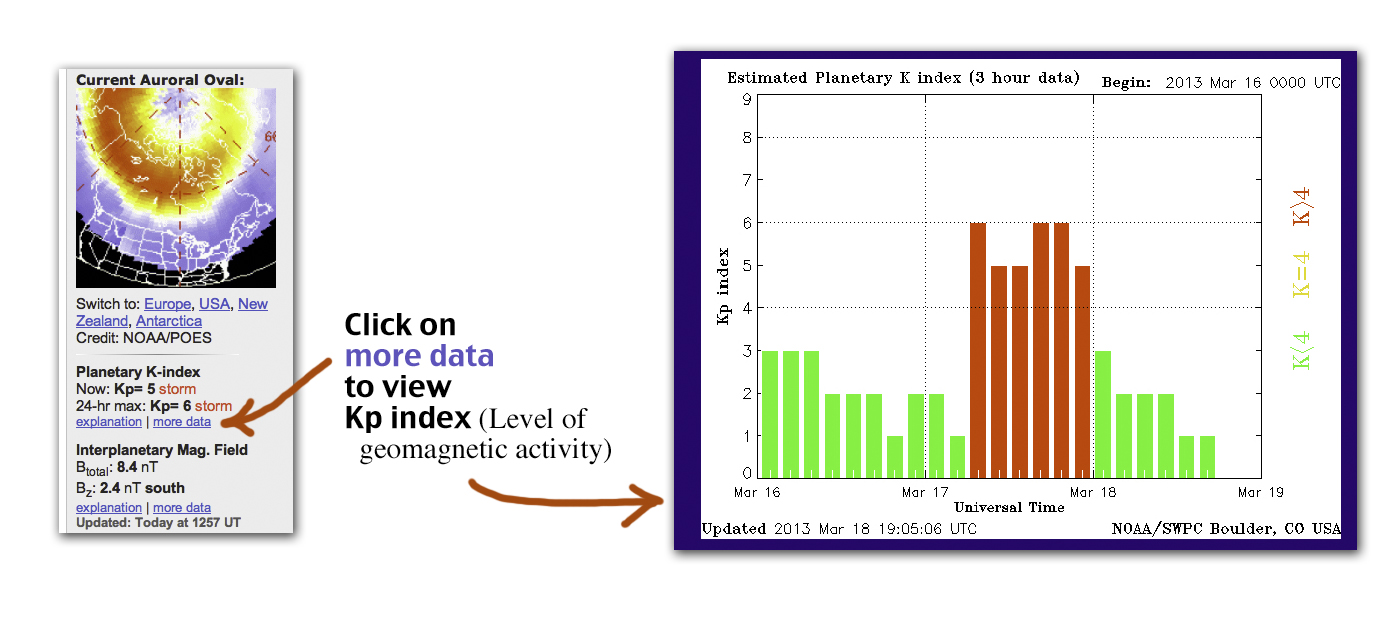
Your Location on the Planet
Generally speaking, you have a better chance of seeing an auroral display if you are at a high latitude, that is, closer to the north or south pole. This seems like a no-brainer, but there’s a catch: The earth’s magnetic poles are not in line with the geographic poles. So how do you know if you’ll see the Aurora?
Let’s say you’ve signed up for a winter photography workshop in Yellowstone National Park. Go to NOAA/Space Weather Prediction Center and scroll down until you find Kp maps of midnight equatorward boundaries. There you’ll see maps for four quadrants of the globe. The map for North America looks like this:

Map of North America showing Kp index along geomagnetic lines (from NOAA/Space Weather Prediction Center) . Helpful for determining your ability to view the northern lights. There are three additional maps: Eurasia, South America and Eastern Pacific and Africa-Indian Ocean-Australasia.
This map shows how high the Kp index needs to be for you to see the aurora at your magnetic latitude. To explain: When geomagnetic activity is low (Kp=3), the aurora activity is located at about 67 degrees magnetic latitude (N or S). Now I’m a former merchant marine officer, so this all makes perfect sense to me, but for landlubbers, just look for the blue (Kp=3) line on the chart.
As the Kp index number increases, say to Kp=9 (which is extraordinary), the aurora may be seen at lower latitudes such as Colorado and Virginia, as seen by the red line on the chart.
To summarize, once you know your magnetic latitude, frequently check the Kp index on Spaceweather.com and the Space Weather Prediction Center’s Solar-Geophysical Forecast. Finally, if you think there’s a possibility that the lights will be on, and you really, really REALLY want to make sure you see them on any given night, drink a big glass of water before you go to bed.
In my next installment, I’ll share tips for photographing the northern lights: Clothing, equipment, camera gear, exposures, composition tips, suggestions for post-processing, and the best times to see The Lights.
Meanwhile, thanks for visiting, and keep looking up!
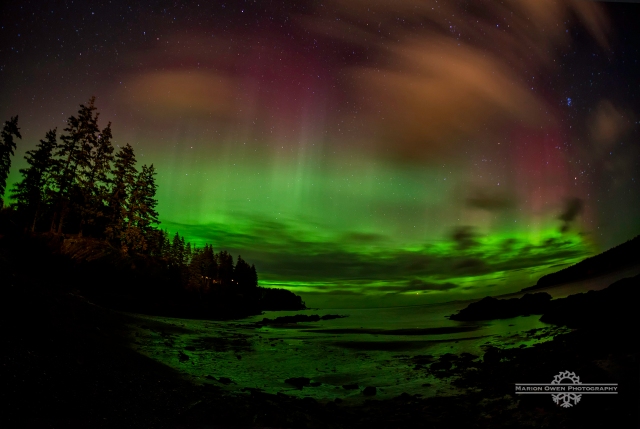
SKY SHERBET: The Aurora Borealis stirred up a sweet rainbow of lime, raspberry and orange over Mill Bay Beach in Kodiak, Alaska. A good northern lights image must have a strong composition to begin with. Expect the unexpected, too. The pastel orange clouds are the result of nearby streetlights. (Canon 5D Mark II, f/4, 30 sec, ISO 1600)

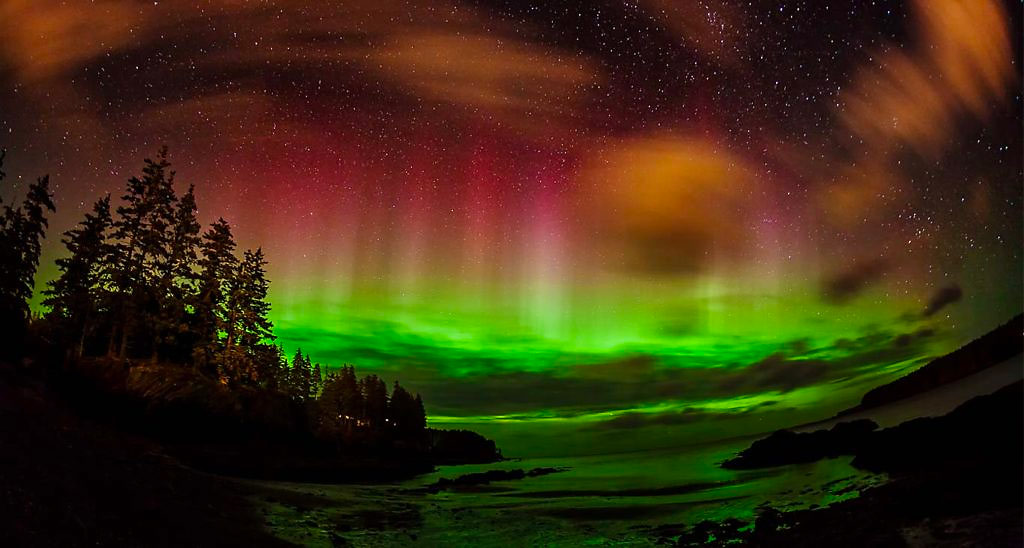
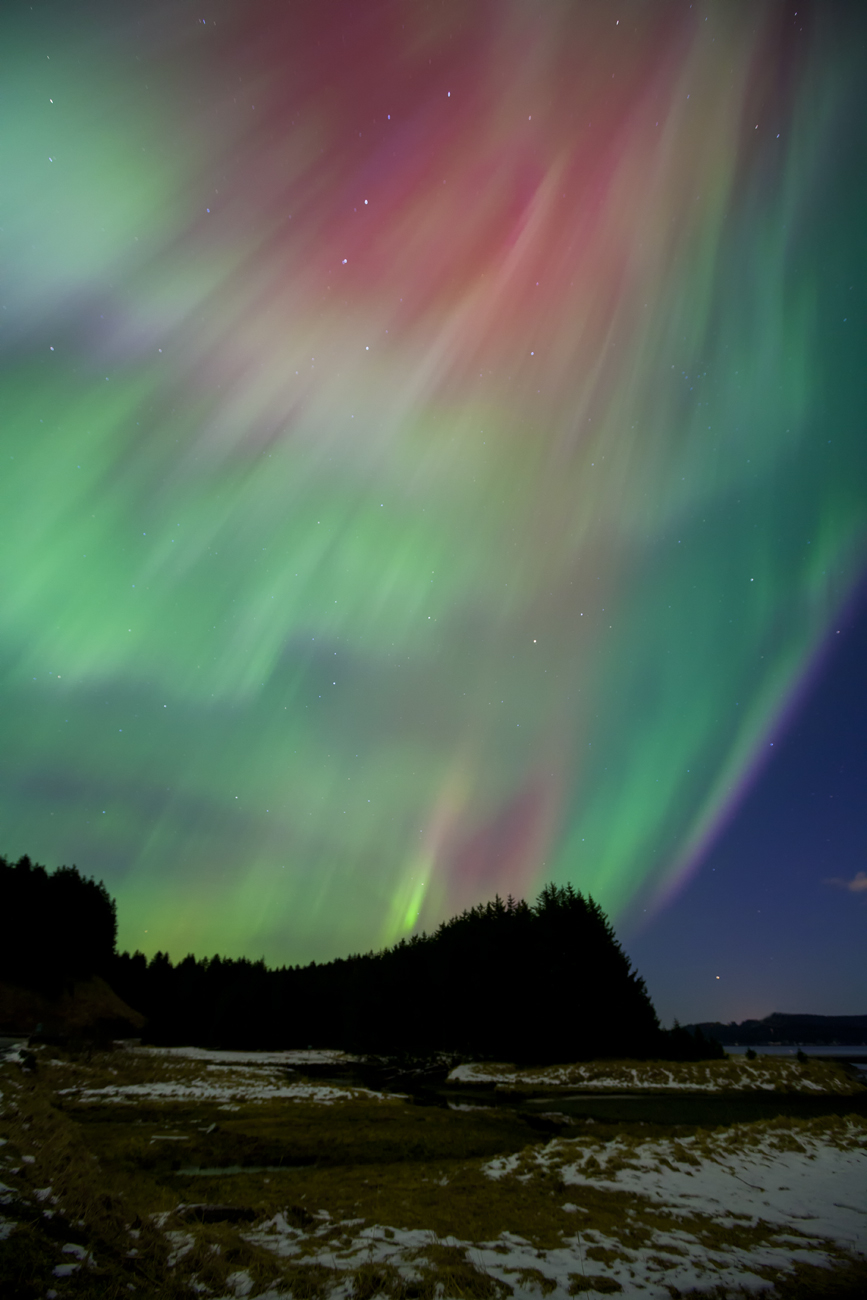

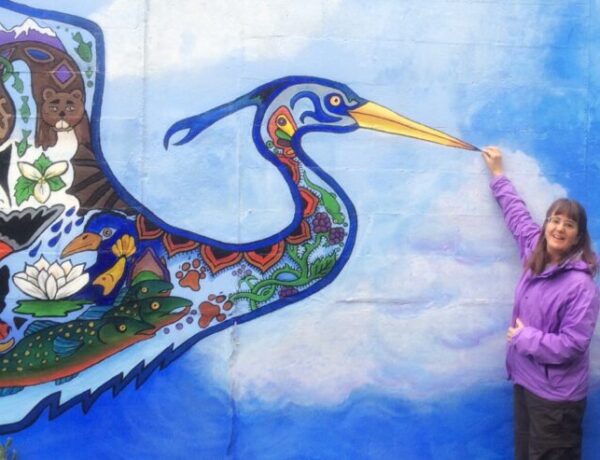
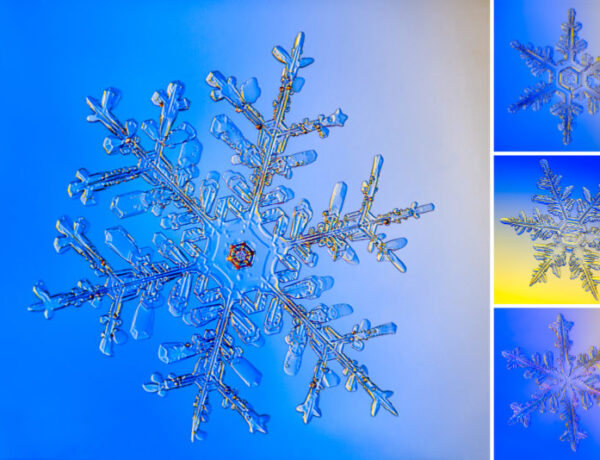
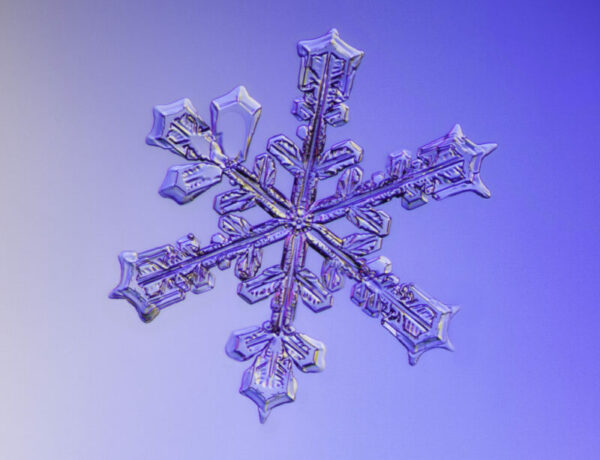
7 Comments
Tony
December 27, 2013 at 12:23 PMHi Marion,
We can also throw our hat in the ring for latest aurora forecasts. We use data from Nasa’s solar wind satellite. Check out our aurora forecast page, it has hourly and daily forecast and tons of solar wind data. http://www.aurora-service.org/aurora-forecast/
Clear skies,
Tony
marionowen
January 4, 2014 at 8:47 PMThanks, Tony!
rjmonroe968
December 21, 2013 at 5:27 AMThanks for your beautiful photos, and the tip about that unique Kp website. Talk about fabulous holiday lights! Inspiring! Peace to you and yours.
marionowen
December 21, 2013 at 7:32 AMYou’re most welcome. I’m happy to share what I know to help others pursue beauty — and yes, peace. Merry Christmas to you and yours. And Happy Solstice!
juliecrombe
December 20, 2013 at 12:32 PMBoth the first and the last shot are amazing!
Please check out my blog too and let’s follow each other!
http://www.juliecrombe.com
marionowen
December 20, 2013 at 1:26 PMThanks, Julie. Your blog is delightful.